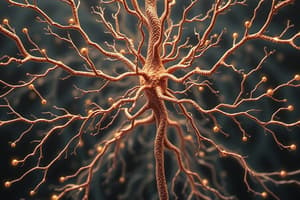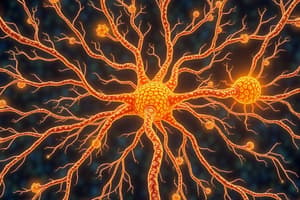Podcast
Questions and Answers
What triggers the opening of Na+/K+ channels in the motor end plate?
What triggers the opening of Na+/K+ channels in the motor end plate?
- Depolarization of the motor end plate
- Binding of two molecules of ACh (correct)
- Binding of one molecule of ACh
- Calcium influx
The somatic motor division controls smooth muscle contraction.
The somatic motor division controls smooth muscle contraction.
False (B)
What is the primary neurotransmitter involved in muscle fiber contraction at the neuromuscular junction?
What is the primary neurotransmitter involved in muscle fiber contraction at the neuromuscular junction?
ACh
At the resting membrane potential, the driving force on ______ into the cell is greater than the driving force on K+ out of the cell.
At the resting membrane potential, the driving force on ______ into the cell is greater than the driving force on K+ out of the cell.
Match the components of the autonomic nervous system with their descriptions:
Match the components of the autonomic nervous system with their descriptions:
Which subdivision of the motor division innervates skeletal muscles and is responsible for voluntary movements?
Which subdivision of the motor division innervates skeletal muscles and is responsible for voluntary movements?
The sympathetic nervous system is primarily responsible for 'rest and digest' activities.
The sympathetic nervous system is primarily responsible for 'rest and digest' activities.
What are the two subdivisions of the autonomic nervous system?
What are the two subdivisions of the autonomic nervous system?
The ________ is responsible for regulating homeostasis in the body.
The ________ is responsible for regulating homeostasis in the body.
Match the subdivisions of the autonomic nervous system with their primary functions:
Match the subdivisions of the autonomic nervous system with their primary functions:
Which of the following is NOT a characteristic of the autonomic nervous system?
Which of the following is NOT a characteristic of the autonomic nervous system?
The autonomic nervous system consists of a single neuron pathway between the CNS and target cells.
The autonomic nervous system consists of a single neuron pathway between the CNS and target cells.
What is the role of the postganglionic neuron in the autonomic nervous system?
What is the role of the postganglionic neuron in the autonomic nervous system?
What type of neuron directly synapses on skeletal muscle fibers?
What type of neuron directly synapses on skeletal muscle fibers?
Muscarinic receptors are found exclusively in the central nervous system.
Muscarinic receptors are found exclusively in the central nervous system.
What is the role of calcium ions (Ca2+) in the neuromuscular junction?
What is the role of calcium ions (Ca2+) in the neuromuscular junction?
The somatic motor neuron connects to skeletal muscle fibers in a __________ manner.
The somatic motor neuron connects to skeletal muscle fibers in a __________ manner.
Match the following terms with their correct descriptions:
Match the following terms with their correct descriptions:
Which of the following is NOT a function of the somatic motor division?
Which of the following is NOT a function of the somatic motor division?
The axon terminals of somatic motor axons can branch to synapse with multiple muscle fibers.
The axon terminals of somatic motor axons can branch to synapse with multiple muscle fibers.
What is found at the axon terminal of the somatic motor neuron during synaptic transmission?
What is found at the axon terminal of the somatic motor neuron during synaptic transmission?
Where are the pre-ganglionic neurons for the parasympathetic division primarily located?
Where are the pre-ganglionic neurons for the parasympathetic division primarily located?
The sympathetic division uses acetylcholine as the neurotransmitter for its post-ganglionic neurons.
The sympathetic division uses acetylcholine as the neurotransmitter for its post-ganglionic neurons.
What type of receptors do target cells express in the sympathetic division?
What type of receptors do target cells express in the sympathetic division?
Both parasympathetic and sympathetic pre-ganglionic neurons use __________ as their neurotransmitter.
Both parasympathetic and sympathetic pre-ganglionic neurons use __________ as their neurotransmitter.
Match the following receptor types with their characteristics:
Match the following receptor types with their characteristics:
Which of the following best describes the location of autonomic ganglia in the sympathetic division?
Which of the following best describes the location of autonomic ganglia in the sympathetic division?
Nicotinic receptors can be activated by both acetylcholine and nicotine.
Nicotinic receptors can be activated by both acetylcholine and nicotine.
What ions move through the channel when nicotinic receptors are activated?
What ions move through the channel when nicotinic receptors are activated?
Where are the cell bodies of the sympathetic preganglionic neurons located?
Where are the cell bodies of the sympathetic preganglionic neurons located?
Parasympathetic post-ganglionic neurons are located far from the target tissue.
Parasympathetic post-ganglionic neurons are located far from the target tissue.
What differentiates the neurotransmitters used by the sympathetic and parasympathetic divisions?
What differentiates the neurotransmitters used by the sympathetic and parasympathetic divisions?
The cell bodies of the sympathetic post-ganglionic neurons are located in the ________.
The cell bodies of the sympathetic post-ganglionic neurons are located in the ________.
Match the following components of the autonomic nervous system with their characteristics:
Match the following components of the autonomic nervous system with their characteristics:
Which of the following is NOT a characteristic that differentiates sympathetic from parasympathetic divisions?
Which of the following is NOT a characteristic that differentiates sympathetic from parasympathetic divisions?
The neurotransmitter receptors for target cells in the autonomic nervous system are located at specific synaptic locations.
The neurotransmitter receptors for target cells in the autonomic nervous system are located at specific synaptic locations.
Name one location where the cell bodies of parasympathetic preganglionic neurons are found.
Name one location where the cell bodies of parasympathetic preganglionic neurons are found.
Flashcards are hidden until you start studying
Study Notes
Efferent (Motor) Division
- The Efferent (Motor) Division of the Nervous System is responsible for carrying signals from the CNS to the body.
- The Efferent Division of the Nervous System has two subdivisions: the Somatic Motor subdivision and the Visceral Motor subdivision (Autonomic Nervous System, ANS).
Somatic Motor Subdivision
- The Somatic Motor subdivision innervates skeletal muscles of the body.
- The Somatic Motor subdivision is responsible for voluntary movements.
Visceral Motor Subdivision (ANS)
- The Visceral Motor subdivision (Autonomic Nervous System, ANS) regulates smooth muscle of the digestive tract, blood vessels, ducts of glands, airways, urinary bladder, cardiac muscle, and secretion of salivary glands and some endocrine glands.
Features of the ANS
- The ANS is involuntary and operates without conscious control.
- The ANS has two subdivisions:
- Parasympathetic subdivision: known as "rest and digest" prepares the body for rest and digestion activities.
- Sympathetic subdivision: known as "fight or flight" prepares the body for energetic action.
Autonomic Division: Homeostasis
- The Parasympathetic and Sympathetic subdivisions are always active and work together to maintain homeostasis.
- Most tissues, but not all, are under antagonistic regulation by the two ANS subdivisions.
Autonomic Control Centers
- The hypothalamus is the center for homeostasis integration and regulates water balance, temperature, and hunger.
- The pons controls respiration, cardiac function, and urinary bladder function.
- The medulla controls respiration and blood pressure.
Comparing the Sympathetic and Parasympathetic Subdivisions
- Autonomic pathways between the CNS and their target cells consist of two neurons, making them di-synaptic.
- The preganglionic neuron originates in the CNS and synapses with the postganglionic neuron in an autonomic ganglion.
- The postganglionic neuron projects its axons to their target tissues, which could be endocrine or exocrine gland cells, smooth muscle cells, or adipose cells.
Sympathetic versus Parasympathetic: Location of pre- and post-ganglionic cell bodies
- Sympathetic preganglionic neurons are located in the thoracic and first two lumbar segments of the spinal cord.
- Sympathetic postganglionic neurons are located in the sympathetic ganglion chain near the spinal cord and the three ganglia along the aorta.
- Parasympathetic preganglionic neurons are located in the pons, medulla and sacral segments of the spinal cord.
- Parasympathetic postganglionic neurons are located near or on the target tissue.
Summary of Sympathetic versus Parasympathetic Subdivisions
- In terms of the location of preganglionic neurons, Parasympathetic neurons are located in the pons, medulla, and segments 2-4 of the sacral spinal cord. Sympathetic neurons are located in the thoracic and lumbar segments of the spinal cord.
- In terms of the location of autonomic ganglia, Parasympathetic ganglia are on or near the target tissue. Sympathetic ganglia are located in the sympathetic chain of ganglia close to the vertebral column and along the abdominal aorta.
- In terms of receptor types, both pre and postganglionic Parasympathetic neurons express nicotinic receptors, while target cells express muscarinic receptors. Sympathetic postganglionic neurons express nicotinic receptors, while target cells express adrenergic receptors.
- Both pre and postganglionic Parasympathetic neurons use acetylcholine as their neurotransmitter. Sympathetic preganglionic neurons use acetylcholine. Sympathetic postganglionic neurons use norepinephrine.
More On Cholinergic Receptors
- Acetylcholine uses two types of receptors:
- Nicotinic receptors: are named after the agonist nicotine, which is also known to activate these receptors. Found on dendrites and cell bodies of postganglionic neurons in both subdivisions of the ANS and on skeletal muscle fibers. They consist of four protein subunits that create a chemically gated ion channel in the cell membrane. They require binding of two acetylcholine molecules to open, allowing Na+ and K+ to move across the membrane, leading to a fast synaptic response. Due to more Na+ entering than K+ leaving, a depolarization occurs.
- Muscarinic receptors: are named after the agonist muscarine, which also activates these receptors. Found on the cell membrane of target cells in the parasympathetic subdivision, pacemaker cells of the heart, and other target cells. They consist of a single protein subunit that spans the cell membrane and are linked to G-proteins. They are activated by a single acetylcholine molecule, activating a second messenger system resulting in a slow synaptic response.
Somatic Motor Division
- The Somatic Motor Division provides voluntary control of body movement.
- The neuron innervating a skeletal muscle fiber is called a somatic motor neuron.
- The cell body of a somatic motor neuron is located in the CNS, directly projecting to the skeletal muscle fibers for voluntary muscle control.
Somatic Motor Division
- In the Somatic Motor subdivision, the connection between the CNS and the target (skeletal muscle fiber) is monosynaptic.
- The somatic motor neuron sends axons directly to synapse on the skeletal muscle fiber, with axons potentially being several feet long.
- These axons can branch to synapse with multiple muscle fibers in the muscle.
- Axon terminals of a somatic motor neuron form a chemical synapse on a muscle fiber called a neuromuscular junction.
Structure of the Neuromuscular Junction
- The neuromuscular junction is the site where a somatic motor neuron synapses with a skeletal muscle fiber, consisting of the somatic motor axon terminal, the synaptic cleft, and the motor end plate of the muscle fiber.
Events at the Neuromuscular Junction leading to muscle fiber contraction
- An Action potential travels down the somatic motor axon and depolarizes the axon terminal.
- Depolarization opens voltage-gated Ca2+ channels, allowing Ca2+ to enter.
- Ca2+ triggers the binding of synaptic vesicles to docking proteins on the presynaptic membrane, releasing ACh into the synaptic cleft.
- ACh diffuses across the cleft and binds to nicotinic receptors on the motor end plate.
- Binding of ACh to nicotinic receptors opens Na+/K+ channels on the motor end plate, allowing Na+ influx and K+ efflux, leading to a depolarization that leads to muscle fiber contraction.
Summary of the Motor Division
- The Motor division consists of the Somatic Motor Division and the ANS.
- The ANS has a central role in homeostasis and is controlled by the CNS.
- The ANS is divided into sympathetic and parasympathetic subdivisions, both of which regulate gland secretion, smooth and cardiac muscle activity, and adipose cell fat storage.
- The Somatic Motor Division controls skeletal muscle contraction, using a monosynaptic connection between the CNS and muscle fiber, with the release of ACh at the neuromuscular junction triggering muscle fiber contraction.
Studying That Suits You
Use AI to generate personalized quizzes and flashcards to suit your learning preferences.




